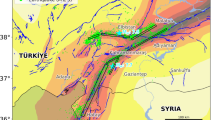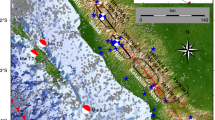Abstract
In the southeastern part of Tibet, an earthquake with a local magnitude of 6.9 occurred in the prefecture of Mainling on 18 November 2017. The mainshock and more than 900 aftershocks were recorded by a local seismic network comprising seven three-component seismic stations. In this study, both HypoDD location of aftershocks and focal mechanism inversion of moderate events were performed in order to accurately identify the pattern of active faults. The result reveals that the mainshock has a thrust source mechanism located at a depth of 14 km beneath the NE flank of the Namcha Barwa–Gyala Peri (NB-GP) massif. The aftershock sequences are caused mainly by two determined faults, one of which is the seismogenic fault stretching with a SE–NW trend parallel to the GP ridge and with a high NE-oriented dipping angle, and the other is activated by the mainshock and displays features of a SSE-NNW trend and SW-dipping, inferring the adjustment of stress in the focal area. The source parameters of the mainshock and the selected aftershocks show the reverse property of the seismogenic fault and its adjunct fault, thus inferring the backlash and uplift of the NB-GP massif, especially GP, for adjusting the uneven extrusion from the eastern Himalayan syntaxis to the adjacent Lhasa block. Furthermore, it is deduced that the rupture energy of the mainshock and aftershocks was limited by the surrounding rigid rock mass with high seismic velocity, such as the Lhasa block in the north and east, and Namcha Barwa complex in the south, and other aftershocks appearing at the NW top of GP and the SE side of Yarlung Tsangpo Big Bend reflect the strong squeezing effect of the NB-GP massif to its northeastern geological mass.













Similar content being viewed by others
References
Bai, L., Li, G., Khan, N. G., Zhao, J., & Ding, L. (2017). Focal depths and mechanisms of shallow earthquakes in the Himalayan–Tibetan region. Gondwana Research,41, 390–399.
Booth, A. L., Zeitler, P. K., Kidd, W. S. F., Wooden, J., Liu, Y., Idleman, B., et al. (2004). U-Pb zircon constraints on the tectonic evolution of southeastern Tibet, Namche Barwa Area. American Journal of Science,304, 889–929. https://doi.org/10.2475/ajs.304.10.889.
Burg, J. P., Davy, P., Nievergelt, P., Oberli, F., Seward, D., Diao, Z., et al. (1997). Exhumation during crustal folding in the Namche-Barwa syntaxis. Terra Nova,9, 53–56. https://doi.org/10.1111/j.1365-3121.1997.tb00001.x.
Chang, L. J., Wang, C. Y., & Ding, Z. F. (2015). Upper mantle anisotropy of the eastern Himalayan syntaxis and surrounding regions from shear wave splitting analysis. Science China Earth Sciences,45, 577–588. (in Chinese).
Cheng, C., Bai, L., & Ding, L. (2017). Crustal structure of Eastern Himalayan Syntaxis revealed by receiver function method. Chinese Journal of Geophysics,60, 2969–2979. (in Chinese).
Deng, Q. D. (2007). Map of active tectonic in China. Beijing: Seismological Press. (in Chinese).
Ellsworth, W. L., & Koyanagi, R. Y. (1977). Three-dimensional crust and mantle structure of Kilauea Volcano, Hawaii. Journal of Geophysical Research,82, 5379–5394.
Hu, S. Q., & Yao, H. J. (2018). Crustal velocity structure around the eastern Himalayan syntaxis: Implications for the nucleation mechanism of the 2017 Ms 6.9 Mainling earthquake and regional tectonics. Tectonophysics,744, 1–9.
Jiang, M., Peng, M., & Wang, Y. X. (2012). Geophysical evidence for deep subduction of Indian lithospheric plate beneath Eastern Himalayan Syntaxis. Acta Petrologica Sinica,28, 1755–1764. (in Chinese).
Kissling, E., Ellsworth, W. L., Eberhart-Phillips, D., & Kradolfer, U. (1994). Initial reference models in local earthquake tomography. Journal of Geophysical Research: Solid Earth,99, 19635–19646. https://doi.org/10.1029/93JB03138.
Malloy M. (2004) Rapid erosion at the Tsangpo knickpoint and exhumation of southeastern Tibet, M.S. thesis, Bethlehem, Pennsylvania, Lehigh University, 84 p.
Peng, C., Yang, J., Wang, W., Zheng, Y., Jiang, X., Han, J., et al. (2018). The Namche Barwa Temporary Seismic Network (NBTSN) and its application in monitoring the 18 November 2017 M 6.9 Mainling, Tibet, China Earthquake. Seismological Research Letters,89(5), 1730–1740.
Shao C.R. (2009). Seismicity of the Yarlung Tsangpo Grand Canyon Region, China. Master Dissertation. Institute of Geophysics, China Earthquake Administration.
Sol, S., Meltzer, A., & Bürgmann, R. (2007). Geodynamics of the southeastern Tibetan Plateau from seismic anisotropy and geodesy. Geology,35, 563–566.
Waldhauser F. (2001). HypoDD—A program to compute double-difference hypocenter locations (hypoDD version 1.0-03/2001). US Geol. Surv. Open File Rep., 01,113.
Waldhauser, F., & Ellsworth, W. L. (2000). A double-difference earthquake location algorithm: Method and application to the northern Hayward fault, California. Bulletin of the Seismological Society of America,90, 1353–1368.
Wei, W., Xie, C., Zhou, B. G., Guo, Z., Yin, X. Z., Li, B. H., et al. (2018). Location of the mainshock and aftershock sequences of the M6.9 Mainling earthquake, Tibet. Chin Sci Bull,63(15), 1493–1501. (in Chinese).
Wu, B. F. (2017). Determination of the focal mechanism of Milin M 6.9 earthquake on Nov.18, 2017 in Tibet. Seismological and Geomagnetic Observation and Research, 38(6), 26–29.
Wu, Y. Q., & Huang, W. H. (2010). Digital seismic network data processing system software JOPENS architecture design and implementation. Seismology and Geomagnetic Observation and Research,31(6), 59–63.
Wu, Y. Q., Huang, W. H., & Su, Z. J. (2013). Real-time data transmission and service of Chinese seismic network. South China Journal of Seismology,33(3), 77–84.
Xu, Q., Zhao, J., & Pei, S. (2013). Distinct lateral contrast of the crustal and upper mantle structure beneath northeast Tibetan plateau from receiver function analysis. Physics of the Earth and Planetary Interiors,217, 1–9.
Yang, R., Herman, F., Fellin, M. G., & Maden, C. (2018). Exhumation and topographic evolution of the Namche Barwa Syntaxis, eastern Himalaya. Tectonophysics,722, 43–52.
Yao, H., Van Der Hilst, R., & Montagner, J. (2010). Heterogeneity and anisotropy of the lithosphere of SE Tibet from surface wave array tomography. Journal of Geophysical Research. https://doi.org/10.1029/2009JB007142.
Yin, X. Z., Zhou, B. G., Chen, J. H., Wei, W., Xie, C., & Guo, Z. (2018). Spatial-temporal distribution characteristics of early aftershocks following the M6.9 Mainling earthquake in Tibet, China. Chinese Journal of Geophysics,61(6), 2322–2331. https://doi.org/10.6038/cjg2018l0783. (in Chinese).
Zeitler, P.K., Malloy, M. A., Kutney, M.P., Idleman, B.D., Liu, Y., Kidd, W.S., Booth, A.L. (2006). Geochronological evidence for the tectonic and topographic evolution of SE Tibet. Eos (Transactions, American Geophysical Union) 87: Abstract T23B–0480.
Zeitler, P. K., Meltzer, A. S., Brown, L., Kidd, W. S., Lim, C., & Enkelmann, E. (2014). Tectonics and topographic evolution of Namche Barwa and the easternmost Lhasa block, Tibet. Toward an Improved Understanding of Uplift Mechanisms and the Elevation History of the Tibetan Plateau. Geological Society of America Special Paper,507, 23–58.
Zhang, X., Du, G., Liu, J., Yang, Z., Zou, L., & Wu, X. (2018). An M6.9 earthquake at Mainling, Tibet on Nov.18, 2017. Earth and Planetary Physics, 2(1), 84–85.
Zhu, L. P., & Ben-Zion, Y. (2013). Parametrization of general seismic potency and moment tensors for source inversion of seismic waveform data. Geophysical Journal,194, 839–843.
Zhu, L. P., & Rivera, L. A. A. (2002). Note on the dynamic and static displacement from a point source in multilayered media. Geophysics,148, 619–627.
Acknowledgements
This research is supported by the National Key R&D Program of China (grant no. 2018YFC1504001) and the National Nature Science Foundation of China (grant no. 418740750). We acknowledge the contributions by Xue-Cheng Wang and Xiao-Long Wang in deploying the seismographs.
Author information
Authors and Affiliations
Corresponding author
Additional information
Publisher's Note
Springer Nature remains neutral with regard to jurisdictional claims in published maps and institutional affiliations.
Rights and permissions
About this article
Cite this article
Wang, W., Yang, J. & Wang, Y. Seismic Sequences of the 2017 Mainling Mw 6.5 Earthquake: Imaging the Seismogenic Fault by Aftershock Analysis. Pure Appl. Geophys. 177, 3161–3174 (2020). https://doi.org/10.1007/s00024-020-02422-2
Received:
Revised:
Accepted:
Published:
Issue Date:
DOI: https://doi.org/10.1007/s00024-020-02422-2




